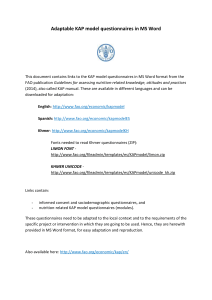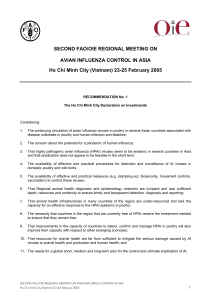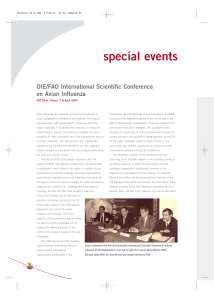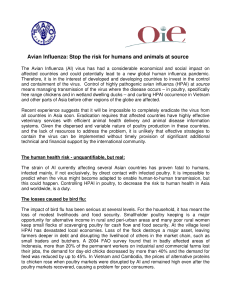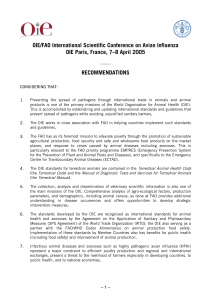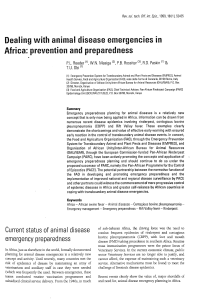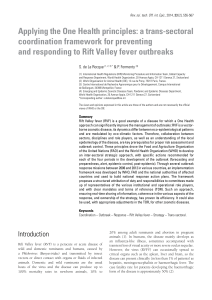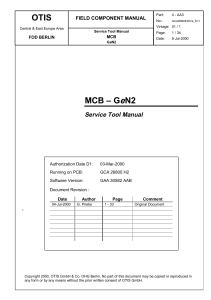Session 6 6 Gwenaelle Dauphin
publicité
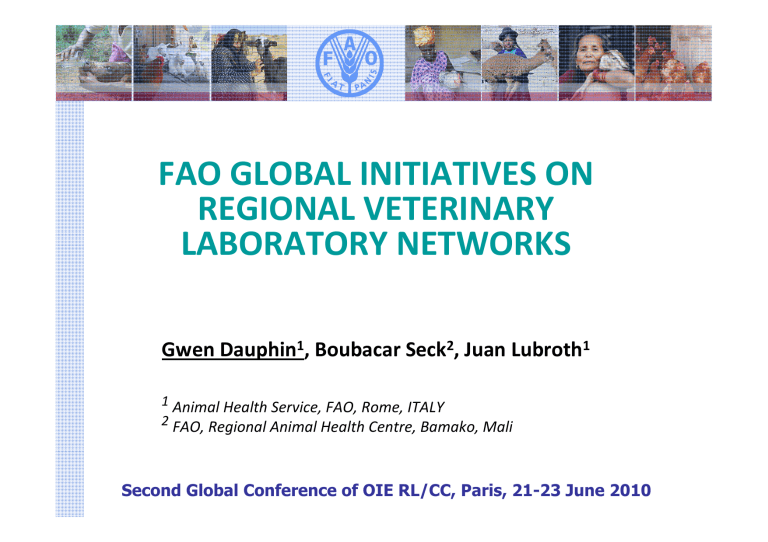
FAO GLOBAL INITIATIVES ON REGIONAL VETERINARY LABORATORY NETWORKS Gwen Dauphin1, Boubacar Seck2, Juan Lubroth1 1 Animal Health Service, FAO, Rome, ITALY 2 FAO, Regional Animal Health Centre, Bamako, Mali Second Global Conference of OIE RL/CC, Paris, 21-23 June 2010 FAO activities • • • • UN agency for Food and Agriculture Animal Health and Production division FAO HQ/regional/subregional/country offices Avian influenza (2005-2010): – – – – 170 projects 38% with a lab component 310 million $ Regional approach was chosen: regional TCP projects, RAHC, creation of regional networks – Up to 500 staff employed: many on the ground At country level • The last 5 years: diagnostic capacities and laboratory capabilities have been greatly improved in many developing and transition countries • Medium to long term issues need to be addressed to build on the funds and efforts invested during the HPAI crisis • Strengthening lab capacities are only part of the picture: staff turn over, sufficient lab funding, sample submission, interface with epidemiologists, integration of labs in the animal health business, etc FAO’s approach to lab networks Justification of regional networks • Within regions: more harmonization - political weight coordination of activities – information/experience sharing • Breaking the isolation of national teams • Capacity building • Easier links with other networks/regions • Diagnostics proficiency tests FAO’s approach to lab networks Coordination • Global focal point in HQ/regional focal points (lab+epi) • Coordination from HQ with FAO regional offices • FAO coordination/support to networks: preparation and implementation of workplans, annual meetings, training programmes, procurement, laboratory assessments, fund raising etc. FAO’s approach to lab networks Membership • Network of all national veterinary labs of a region • Both institutional and human networks • Selection of regional laboratories and specific support provided to regional laboratories (ie. workplans, twinning, incl. OIE) FAO’s proposed approach: Based on people • Nominate the national focal points • Form database of regional resource persons • Build a consortium among regional experts and international experts • Make a mailing list FAO’s proposed approach: Collaborations • With international RL/CC (FAO/OIE) • Possibility of sub-networks/groups: – for specific objectives (ie groups with/without PCR) – for training activities (ie quality assurance) – for specific diseases (RVF) • Close links with the Epidemiology Network: necessary (samples collection/testing/lab data compilation) • Connections with other lab networks (i.e. IAEA, public health, regional, OFFLU) FAO’s proposed approach: Regional labs • No legal status (common agreement) • Selection process, criteria for selection and TOR to be defined by the region • FAO can assist in the criteria definition and selection process FAO’s proposed approach: Possible roles of regional labs • • • • • • • Providing regional trainings Tests validation Production of reference reagents Proficiency testing Regional laboratory meetings Facilitation of international sample shipment Referral and confirmation services Focus on one network: RESOLAB (1) launched in Dec 2007 • • • • • • • • • Lab grouping Designation of 2 regional labs >300 lab staff trained (lab techniques, QA) 2 rounds of AI/ND proficiency testing 3 annual meetings with recommendations Quarterly reports Communication: mailing list and website 21/23 labs assessed Good knowledge of individual lab conditions Focus on one network: RESOLAB (2) • Substantial support to regional labs (supplies, training, participation to intern. conf, scholarship) • Procurement of basic items: shipment boxes, basic equipment calibration kit, PCR/serology reagents • Contract with OIE/FAO RL for training, sample primary and advanced testing, attendance to annual meetings • Study on opportunities of partnerships with the animal industry to enable complementary sources of funding • International collaboration/funding: USDA, CDC, IZSVe, CIRAD, USAID, FVI, EU-FMD... RESOLAB: Future activities • Create a steering committee • Advocacy for commitment of national governments/REC • Harmonization of protocols • Twinning programs (intra/outside region) • Entry point for lab strengthening projects • Fund raising FAO Reference centres • Recent FAO policy (Oct 2006) for all disciplines under the mandate of FAO • To be adapted to the animal health needs/specificities • About 100 RL+CC, all under the same designation as Reference Centres FAO Reference centres: FAO system compared to the OIE one FAO Reference Centre: Avian influenza (AI) and Newcastle Disease (ND) Work plan • • • • Long process + new Comparable mandates More development oriented Gives privilege for projects partnership • Not person but institution-linked designation • Not disease approach but group of diseases Name of the Institution:) Common Workplan FAO AI/ND Reference Centres 1. The Reference Centre (RC) will provide emergency AI and ND reference laboratory services without charge to FAO or to FAO member countries according to the title/function of the reference centre. An emergency is defined as a suspected or confirmed (ongoing) AI and ND outbreak. The limit for this service without charge is suggested to be at least 20 samples per outbreak (or 50 samples per country per year). The RC has the function to type/characterise the AI/ND virus isolates when available and to copy FAO with the report provided to the country/submitting authority, and to deposit within one month the information on the isolated AI/ND virus into a public sequence database (e.g Genbank). 2. The RC will actively contribute to OFFLU, joint OIE-FAO network of expertise on avian influenza, including provision of at least an annual report that includes data on laboratory services performed for the year, and detailed characterisation of samples received for AI/ND viruses typing (if any). 3. The RC will share, in response to requests from FAO and/or another FAO reference centre, biological materials and associated information, in order to improve the performance and harmonisation of AI/ND reference laboratory services; the cost of material shipment should be covered by the requesting laboratory and can be subject to reaching a suitable Material Transfer Agreement (MTA) between the sending and receiving parties. 4. Upon request, the RC will collaborate with FAO on technical projects for the surveillance and control of AI/ND. 5. The RC shall provide technical expert services (consultation, meetings) to FAO, equivalent to at least 10 person days per year, without charge. These services include attendance to teleconferences or other activities in addition to those requiring travel. In case of travel, this cost will be covered by FAO. 6. The RC shall provide an annual report (a short report template will be provided by FAO, with possible online submission) by the end of January each year. Conclusions • Other networking initiatives have succeeded in the past (ex. Rinderpest) • Collaborations with epi/human health sector/other networks • Role of FAO: launch/support/coordinate these networks through regional AH offices • Ultimate goal: establishment, consolidation, sustainability and ownership by national governments and their regional economic organizations. Thank you for your attention...

